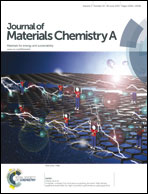Enhancement of capacitive deionization capacity of hierarchical porous carbon†
Abstract
Capacitive deionization (CDI) has attracted huge interest as an energy-efficient and eco-friendly desalination strategy. Its development is presently limited due to the relatively low CDI capacitances of carbon materials. Herein, hierarchical porous carbon materials (HPCs) derived from ethylenediaminetetraacetic acid (EDTA) upon annealing were used, which showed impressive CDI performance with a maximum desalination capacity of 34.27 mg g−1 in 40 mg L−1 NaCl aqueous solution. Such capability was attributed to the appropriate hierarchical pore structure, high specific surface area (2185.71 m2 g−1), large pore volume (1.368 cm3 g−1) and reasonable graphitization degree, which were also confirmed by the high specific capacitances of 182 F g−1 in 1 mol L−1 NaCl and 260 F g−1 in 6 mol L−1 KOH. Since the physisorption capacity was nearly 0, and the regeneration process was facile and complete, such economical HPCs materials show potential for practical desalination applications in the future. Moreover, the HPCs electrodes presented ion selectivity in competitive multi-ionic solutions by kinetic behavior difference or static capacitance difference.


 Please wait while we load your content...
Please wait while we load your content...